 An illustration of human sperm cells racing to fertilize an egg.Illustration: Maria Mellor (Flickr, CC BY 2.0)
An illustration of human sperm cells racing to fertilize an egg.Illustration: Maria Mellor (Flickr, CC BY 2.0)
A pair of Australian siblings are some of the rarest humans ever documented, according to their doctors. The brother and sister are said to be semi-identical twins, sharing the exact same DNA from their mother’s side, but only a portion of their father’s genetic makeup. The children are thought to be only the second case of semi-identical twins discovered, and the first to be identified during pregnancy.
The story of the twins was detailed in a case report published Wednesday in The New England Journal of Medicine. According to the authors, the siblings are a class of twins called sesquizygotic, something of a midpoint between fraternal and identical twins.
Fraternal twins happen when two different sperm cells fertilize two different eggs, creating two different zygotes, both of which end up implanted in the uterus as developing embryos. So they’re as genetically similar (roughly 50 percent) as any two average siblings would be—they’re just born at the same time. Identical twins, on the other hand, are made when the same sperm fertilizes the same egg, but then that zygote splits into two embryos, each sharing the same genetic mix of DNA from mom and dad.
But in this case, the authors theorize, two sperm cells simultaneously fertilized the same egg. Ordinarily, that sort of mistake quickly results in a miscarriage, since humans usually can’t develop with three different sets of chromosomes. Somehow, though, the resulting zygote incorporated an equal split of DNA from all three sets, with three groups of cells forming afterward: Cells containing the mother’s DNA and DNA from sperm 1; cells with the mother’s DNA and DNA from sperm 2; and cells containing DNA from only sperm 1 and 2. Over time, the third group of sperm-only cells was effectively crowded out by the cells containing DNA from both parents. Then, even more unexpectedly, the bundle of cells divided into two embryos, creating the twins.
“They are 100 percent identical on the mother’s side and 78 percent identical the father’s side, so this averages out to being 89 percent identical,” lead author Michael Gabbett, a geneticist at Queensland University of Technology, told Gizmodo.
Gabbett and his co-author Nicholas Fisk, an obstetrician and deputy vice-chancellor of research at the University of New South Wales, helped manage the twins’ fetal care at the Royal Brisbane and Women’s Hospital in Queensland in 2014. While it was apparent within weeks of the pregnancy that the mother was having twins, it wasn’t until early in the second trimester that the team noticed something unusual.
“The mother’s ultrasound at six weeks showed a single placenta and positioning of amniotic sacs that indicated she was expecting identical twins,” Fisk said in a statement. “However, an ultrasound at 14 weeks showed the twins were male and female, which is not possible for identical twins.”
“They are 100 percent identical on the mother’s side and 78 percent identical the father’s side, so this averages out to being 89 percent identical.”
Fisk and his team also looked through the medical literature and twin genetic databases for other cases of semi-identical twins. But they only managed to find one other instance. That case, published in 2007 by doctors in the U.S., highlights the complexity of biological sex.
The U.S. doctors reported that the splitting of paternal chromosomes resulted in one twin being intersex, meaning they had ambiguous genitalia; the other was anatomically male. The Y chromosome is usually what determines a person’s sex, with biological males predominantly having XY chromosomes in their cells. Both twins, as it turned out, had a mix of XY and XX sex chromosomes, but the intersex twin only had a 5 percent split of XY compared to XX, while the anatomically male twin had a 50-50 split. The anatomically male twin’s share of XX genes simply wasn’t enough to stop them from developing male sex organs.
“We at first questioned whether there were perhaps other cases which had been wrongly classified or not reported, so we examined genetic data from 968 fraternal twins and their parents,” Fisk said. “However we found no other sesquizygotic twins in these data, nor any case of semi-identical twins in large global twin studies.”
The Australian twins are considered chimeras on their father’s side, with one twin having a roughly 50-50 split of XY and XX sex chromosomes and the other having around a 90-10 split of XX to XY. Unlike the 2007 case, though, the twins are anatomically male and female, respectively. Sadly, the female twin had a unrelated blood clot soon after birth, one that necessitated an amputation of her right arm past the shoulder. She was also later diagnosed with gonadal dysgenesis, a congenital condition linked to cases of rare chromosome configurations. The disorder causes a person’s genitalia to not develop normally and to have a high chance of becoming cancerous, so the twin received a precautionary surgery to remove her ovaries.
Still, both twins, now 4 years old, otherwise appear to be developing normally and doing very well, Gabbett told Gizmodo. He and his team plan to continue monitoring the twins for any further complications.
Share This Story